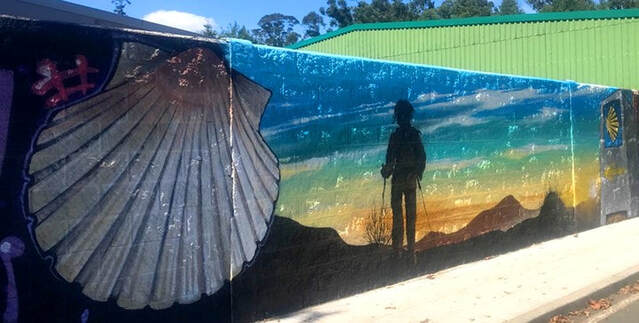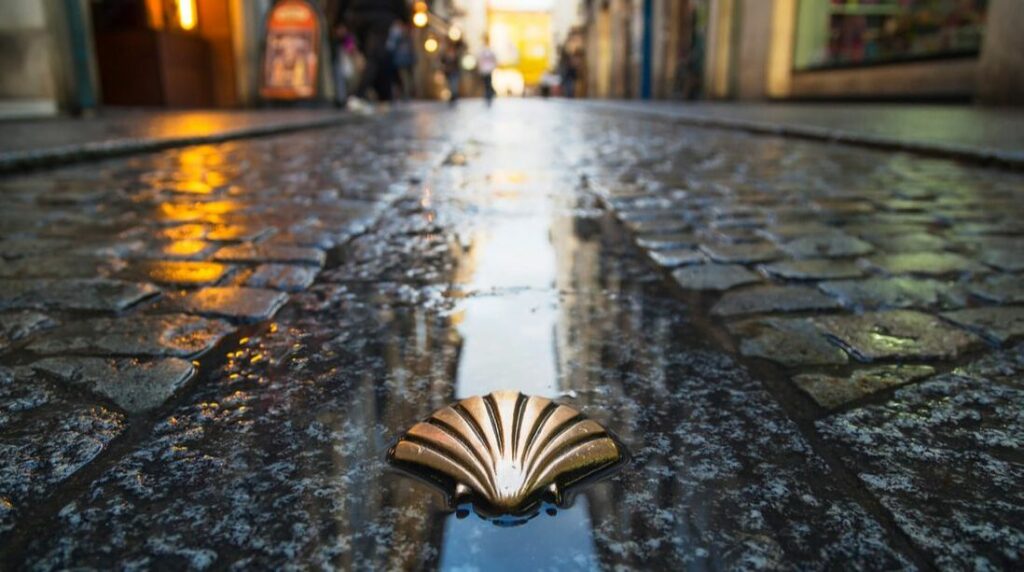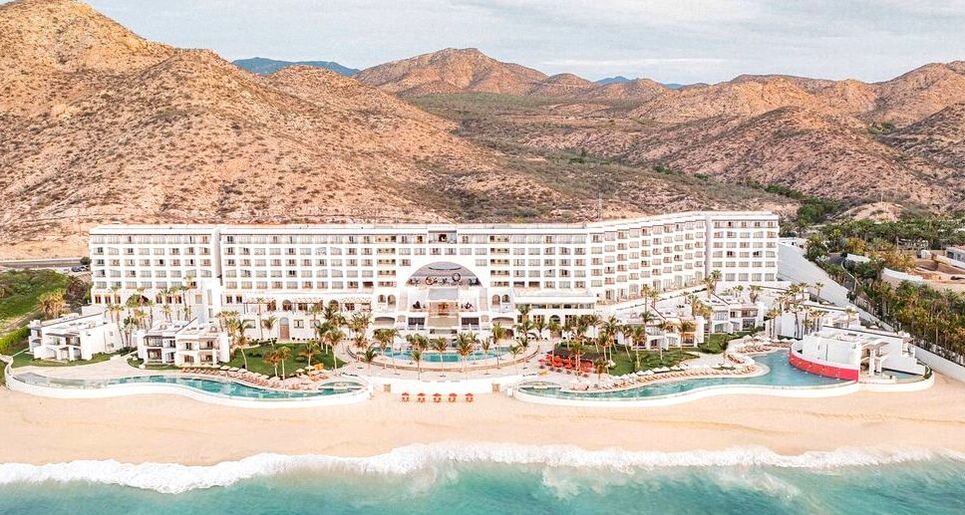The Camino, a Walking Journey for the Soul
Diana Saint James, September 3-15, 2020

“A core question arises: what turns a walking holiday into a pilgrimage?”
A Pilgrim’s Guide to the Camino de Santiago: Camino Francés by John Brierley
My brother Brian and I walked the last 100 km of the Camino de Santiago. It was both challenging and fascinating. We hiked 10-16 miles each day through forests, rolling hills, charming villages, Roman ruins. It is impossible to get lost as the trails are always marked with yellow arrows and scallop shells symbols. The Camino de Santiago dates back to the 9th century when the remains of Christian apostle James were discovered in what is now Santiago de Compostela in northern Spain. The final part of the journey is entering the city gates at Santiago de Compostela and giving thanks at a pilgrim’s mass .
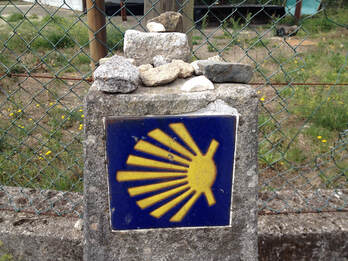
There are a number of pilgrimage paths through France, Spain, and Portugal all leading to the Cathedral at Santiago de Compostela. Like in the movie The Way, many people traditionally start at the France/Spain border and walk 778 kilometers (483 miles) of the “French Way” over the 30-40 days. Growing in popularity is walking the last 100 kilometers (68 miles) of the French Way over a week. 100km is minimum distance required by the Catholic Church to be an official pilgrimage. The 100 km walk can be done on your own or as part of a group. Luggage can be packed on your back, transported for you daily by a tour operator. We used the tour operator, Cosmos, with the Globus Family of Brands. They provided a tour director, map, luggage transfers, hotels, rail tickets, and most dinners at an affordable price.

Day 1: September 5: MADRID: Our tour began tonight at the Orientation & Welcome Dinner at the Hotel Praga. We met our 14 tour companions and local Madrid host, Julian. Everyone was at least 55-75 years old – all nice people. Two couples (Northern CA and Virginia), Brian and me (Northern CA), two retired priests (Nebraska) and the rest were women (Illinois, Minnesota, Southern CA).
Rain is predicted for a good part of our journey ahead. We all anxiously talk about clothing, rain protection, socks, and boot choices. Did we bring the right stuff? Did we train properly? Can we do the 70+ mile walk over the next 5 days? Everyone hoped they had the perfect plan. I had walked four to six miles several times a week over the past six months and did least 9-12 miles in a day a few times in the weeks prior. I had well-broken-in Salomon hiking shoes, medium weight Darn Tough wool socks and an 18 liter Osprey daypack. I’m short (5’0″) so finding the right size pack took time. Fingers crossed this works for me.
Pilgrims from all over the world have walked to Santiago de Compostela for over a thousand years, originally seeking forgiveness for their sins, and most often today they are making a journey of personal growth. They walk for many reasons – to mark a zero birthday, express gratitude, celebrate recovery, or to move on from loss. For me, I’m contemplating the next steps in my life.
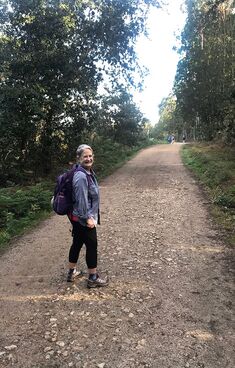
DAY 2: September 6: MADRID–SARRIA Our group transferred by motor coach midday today to Madrid’s Chamartin rail station to board the train for Sarria, 4.5 hours north in the Galicia region of Spain. The town of Sarria, at 117 km away from Santiago de Compostela, has the closest train station to the 100km start point. We had seats in 1st class train coaches. Upon arrival, we checked in at the Alfonso IX Hotel, one of my favorite hotels on the trip for its riverside location.
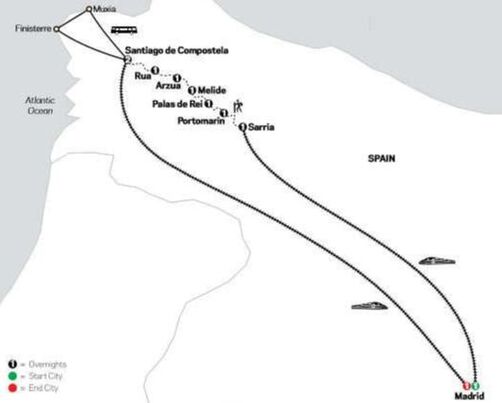
We met Carvin tonight, our local Galician Tour Director. She is a young Australian woman who lives in Spain and speaks fluent Galician Spanish. She is resourceful, funny and easy-going. This is the first Camino Walking Tour that Cosmos has operated in 18 months. She got us all connected together by phone using What’s App, and handed out our Pilgrim Kit that included John Brierley’s Camino Francés guidebook, an official Pilgrim Passport (credential) and the traditional pilgrim’s scallop shell.
DAY 3:September 7: SARRIA–PORTOMARIN We walked 14.7 miles (23 km) today in 6 hours. No rain – whew! It was a peaceful but long walk in shady oak forests and through villages on dirt paths. My brother and I, who have never really hiked together, found that we do walk quite well as a team. It was wonderful to have so much time to talk with Brian. After climbing many stairs to arrive in Portomarin, we checked into Vistalegre Spa Hotel and explored the quaint town.
It seems Galician Spain can be tough for vegetarians. Meals are mainly meat, seafood, potatoes, eggs and rice. Brian is generally a vegetarian and he is having to be flexible. Vegetarian means just no meat in your entree and there were few vegetables served at dinner. We took fruit from the breakfast buffet for trail snacks and found cafes along the way that served salads for lunch.
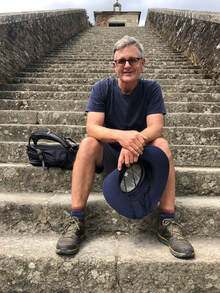
DAY 4: September 8: PORTOMARIN–LESTEDO We walked 16.6 miles (27 km) today in 6.5 hours. At Castromaier, we took a short detour and visited the ruins of an ancient Roman village (4th century BC). As we explored, one of our group members talked about her family’s arduous journey in the 70’s from Vietnam to the USA. We were in awe of their strength.
It poured rain in the afternoon and even with ponchos, we got quite wet. After taking a 1.5 mile detour off the Camino to see Monastery of Our Saviour of Vilar de Donas, a little chapel with 13th century pilgrimage frescos (restored now) and the tombs of nine Knights Templar, whom protected Camino pilgrims across the centuries. But the door was locked due to COVID. Tour Director Carvin found a local woman with a key who unlocked the door. I had a weird feeling that the lifelike knight statues on their tombs would change from stone and come to life – I’ve seen too many movies! We overnighted in Lestedo at a large family estate/farmhouse: Casa Roan y Casa Grande. Thank goodness for hair dryers to dry my shoes. After dinner, the farmhouse owner showed us his copper still and brought out several strong, home-brewed orujo liqueurs for us to taste. It was extra challenging to get up the next day…

DAY 5: September 9: LESTEDO–MELIDE
We walked 16 miles (26 km) today in 6.5 hours. Enjoying our dry morning, the Camino took us past acres of farmland and over medieval bridges. I even made a new friend. We stopped outside Melide for lunch where the Galician delicacy is savory grilled polbo a feira octopus. We had more rain this afternoon and got soaking wet and completely lost in town (no internet signal for GPS) before we found our way to Pension San Anton in Melide. This was the funkiest place we stayed in. I had an odd rooftop room with a skylight, no windows. Only one hairdryer for the whole hotel, so my shoes would be was damp the next morning.
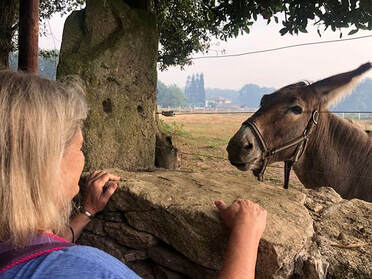
We had a big dinner at 9:00pm at a nearby local restaurant. It is not easy for me to eat so late. Dinners after 9:00pm are traditional in Spain but they can be tiring for foreign pilgrimages after arduous days with early starts. All of our delicious dinners were multi-course and hearty with generous wine/beer pours. But it was not comfortable going to bed so full. Eventually some in our group started skipping dinner, and eating bigger lunches and late afternoon tapas.
Day 6: September 10 MELIDE–ARZUA
We walked 9.5 miles (15 km) in 4 hours on this sunny day. It was very important to stay hydrated before, during, and after each day’s walk. Brian and I drank all local water from the tap and were fine. Others in the group would drink only bottled water. I only got one small blister from yesterday’s wet socks. Thank goodness for Compeet blister pads. Others in our group dealt with big blisters and chronic pain and to their credit, they would all finish the pilgrimage.
For a time today we walked with one of our group members who is recovering from cancer. Her fierce commitment to complete the journey is admirable. We stayed at Hotel Arzua and dinner was a massive but delicious seafood paella. Arzua is a modern town that circles around its medieval center. We went to mass tonight at the Church of St. James.

Day 7: September 11: ARZUA–AMENAL
We walked 15.5 mi in 6 hours. The route today is over gentle slopes and through woodland, with some stretches along a busy road, which we had to cross on occasions. We came upon the Chapel of St. Irene with a spring renowned to be a “fountain of youth”. Reluctant to drink from it, I did wash my face in it but have not noticed a difference L. The rest of the route to Amenal was a mix of country roads and shady forest tracks. We were shuttled to a very nice, huge 4* hotel, Gran Hotel Los Abetos with great views of the region just outside of Santiago de Compostela. Tonight one of our group members told us about her struggles as an immigrant, how much the Church had helped her and her conversion to Catholicism. One of our group members fell today, sprained her wrist and bruised 2 ribs. After an emergency room visit, she returned still fiercely intent on finishing the Camino tomorrow.
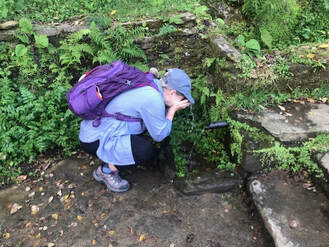

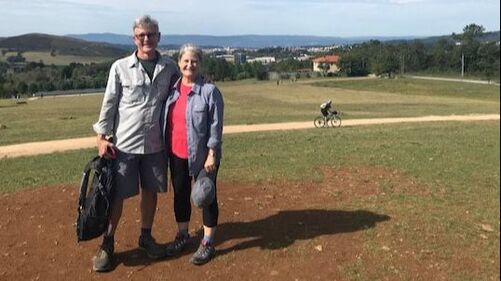
Day 8: September 12: AMENAL–SANTIAGO DE COMPOSTELA
This is the final stage of our Camino. We walked 9.5 mi in 4 hours. There was a steep climb up to San Marcos, then we stopped at Monte do Gozo (Mountain of Joy) where we caught our first glimpse of the spires of the cathedral in Santiago de Compostela. Our group met up at a café for lunch so we could enter the city walls together.
Finally…we entered the old city walls of Santiago de Compostela. We made our way to the main square marking the end of our long walk. I DID IT! I felt joy, relief, and a huge sense of accomplishment.
We gathered for a group photo with the cathedral in the background. Since I walked at least 100 kilometers of the Camino I did receive my Compostela, the Certificate of Accomplishment. Cosmos took care of validating our fully stamped passports with the pilgrimage office so we did not have to wait in the long lines to get it. We attended the 6:00pm mass in the beautiful cathedral and Cosmos had arranged for priority seating. While we could see the botafumeiro (a giant hanging incense burner), it is only swung like a pendulum at the 12:00 noon mass so we did not see it in action. We stay at the centrally located Hotel Compostela.
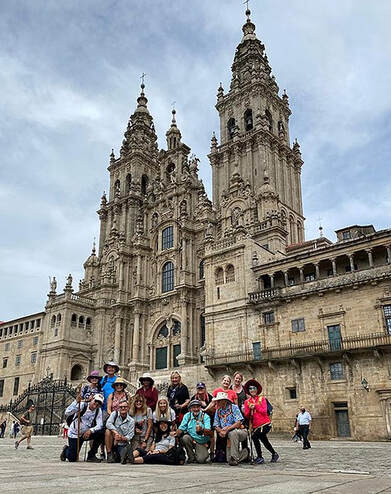
Day 9: September 13: SANTIAGO DE COMPOSTELA & FINISTERRE
It was baking hot today. Our group took a full-day (60 miles) motor coach excursion to the Atlantic Ocean to Cape Finisterre peninsula, believed in Roman times to be the end of the world. Many pilgrims keep walking another four days past Santiago all the way to Finesterre. They used to throw their worn boots into the ocean here (but now that is considered littering) so my brother and I cast stones into the sea to let go of all the things that no longer serve us. On the way home, one of the priests and I talked in depth about the communion host, a fascinating conversation I never expected I would ever have. Meeting the two priests, who actually are siblings and good kind men, has helped me think so much better of the Catholic Church.

Americans need a negative antigen Covid test within 3 days of returning to the USA to re-enter the country. Everyone was thrilled that Cosmos arranged for a nurse to come to the Hotel Compostela to give the tests to the group and even covered everyone’s the testing costs – a very generous gesture. Brian and I and two others needed a PCR Covid test for our British Airways return flights via London. Cosmos even arranged for this test too at a local hospital and covered those tests as well.
In the afternoon, our group took an in-depth guided walking tour of the city center of Santiago de Compostela with a local guide. We joined the queue to go beneath the Cathedral into the Crypt and pause reverently to gaze upon see ornate silver casket that is said to hold the remains of St. James. We walked a very LONG way to see this. Brian and I went out for wine and tapas with the priests – a fitting end to a momentous pilgrimage.
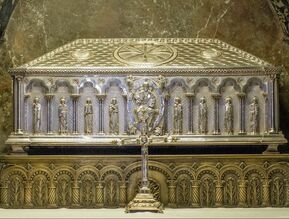
Day 10: September 14: SANTIAGO DE COMPOSTELA–MADRID
This morning we transferred to the Santiago train station for the 4.5 hour train ride back to Madrid. We said goodbye to our Camino/Galician Tour Director Carvin and hello again to our local Madrid host Julian in Madrid. Brian and I made late afternoon trip to visit the Prado (love the intricate art of Hieronymus Bosch) and had dinner at Vega, one of Madrid’s few vegan restaurants. We stayed one final night at the Hotel Praga.
Day 11: September 15: MADRID-LONDON-SAN FRANCISCO
Early pilgrims then had to walk all the way back home again. We were fortunate to have had a morning flight to the UK then a final plane ride home to San Francisco.
Thoughts after the pilgrimage. During the Camino, I didn’t think as many of the profound thoughts as I hoped I would. Traveling in the time of COVID was challenging. The walk logistics often distracted me. But now that I’m home again, I’m seeking joy. The insights are starting to flow and I look forward to where they take me, my career and my relationships in Act III, the next part of my life.
“At the end, ask yourself, what was the gift of the journey and then expand the moment”.
From “The Art of the Pilgrimage – The Seeker’s Guide to Making Travel Sacred” by Phil Cousineau
